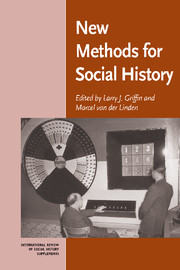Book contents
- Frontmatter
- Contents
- NOTES ON CONTRIBUTORS
- Introduction
- Temporally Recursive Regression and Social Historical Inquiry: An Example of Cross-Movement Militancy Spillover
- Using Event History Analysis in Historical Research: With Illustrations from a Study of the Passage of Women's Protective Legislation
- Incorporating Space into Social Histories: How Spatial Processes Operate and How We Observe Them
- Narrative as Data: Linguistic and Statistical Tools for the Quantitative Study of Historical Events
- The Logic of Qualitative Comparative Analysis
- Historical Social Network Analysis
- Historical Inference and Event-Structure Analysis
Narrative as Data: Linguistic and Statistical Tools for the Quantitative Study of Historical Events
Published online by Cambridge University Press: 04 August 2010
- Frontmatter
- Contents
- NOTES ON CONTRIBUTORS
- Introduction
- Temporally Recursive Regression and Social Historical Inquiry: An Example of Cross-Movement Militancy Spillover
- Using Event History Analysis in Historical Research: With Illustrations from a Study of the Passage of Women's Protective Legislation
- Incorporating Space into Social Histories: How Spatial Processes Operate and How We Observe Them
- Narrative as Data: Linguistic and Statistical Tools for the Quantitative Study of Historical Events
- The Logic of Qualitative Comparative Analysis
- Historical Social Network Analysis
- Historical Inference and Event-Structure Analysis
Summary
This paper illustrates some linguistic and statistical tools that can be profitably used by historians and social historians in the study of events (such as strikes, demonstrations and other types of collective conflict). More specifically, the paper shows that “semantic grammars” provide rigorous tools for the collection of rich event narratives. Semantic grammars structure information around the “canonical form” of the language: noun phrase/verb phrase, or subject, action, object and their modifiers (e.g. time, space). The fact that semantic grammars can be easily implemented in a computer environment using relational database systems (RDBMS) makes feasible the practical application of such powerful coding schemes. The data that computer-based semantic grammars make available are richer, more flexible and more reliable than those delivered by more traditional content analysis methods. They are also very well suited for the application of new tools of data analysis such as network models. Both semantic grammars and network models are fundamentally concerned with actors and their actions, with agents and agency. As such, these linguistic and statistical tools should draw sociology closer to history, traditionally much more concerned with issues of agency. I illustrate the power of both the linguistic and statistical tools using data that I collected from some 15,000 newspaper articles on the 1919–1922 period of Italian history, a period characterized by widespread working-class mobilization (1919–1920, the “red years”) and fascist countermobilization (1921-1922, the “black years”).
- Type
- Chapter
- Information
- New Methods for Social History , pp. 81 - 104Publisher: Cambridge University PressPrint publication year: 1999



